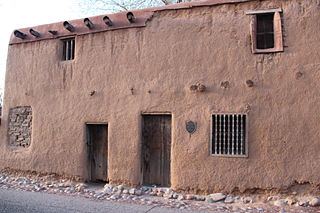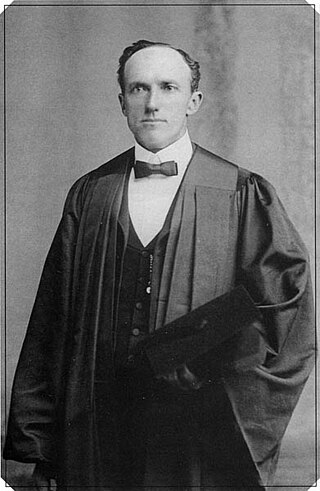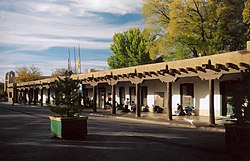
Santa Fe de Nuevo México was a province of the Spanish Empire and New Spain, and later a territory of independent Mexico. The first capital was San Juan de los Caballeros from 1598 until 1610, and from 1610 onward the capital was La Villa Real de la Santa Fe de San Francisco de Asís.

The De Vargas Street House, often referred to as the Oldest House, is a historic building in Santa Fe, New Mexico, which is often said to be one of the oldest buildings in United States. The original date of construction is unknown but the majority of the building is believed to date to the Spanish colonial period (post-1610). One archaeological study also concluded that some sections of the walls are characteristic of Pueblo architecture and may be pre-Spanish in origin. The building was listed on the National Register of Historic Places and New Mexico State Register of Cultural Properties in 1968 as a contributing property in the Barrio De Analco Historic District.

Old Town is the historic original town site of Albuquerque, New Mexico, for the provincial kingdom of Santa Fe de Nuevo México, established in 1706 by New Mexico governor Francisco Cuervo y Valdés. It is listed on the New Mexico State Register of Cultural Properties as the Old Albuquerque Historic District, and is protected by a special historic zoning designation by the city. However, prior to its establishment as a city in the Santa Fe de Nuevo México province, many indigenous tribes lived there including Diné, Pueblo, Apache, Tiwa, and others. The present-day district contains about ten blocks of historic adobe buildings surrounding Old Town Plaza. On the plaza's north side stands San Felipe de Neri Church, a Spanish colonial church constructed in 1793.

Diego de Vargas Zapata y Luján Ponce de León y Contreras (1643–1704), commonly known as Don Diego de Vargas, was a Spanish Governor of the New Spain territory of Santa Fe de Nuevo México. He was the title-holder in 1690–1695, and effective governor in 1692–1696 and 1703–1704. He is known for leading the reconquest of the territory in 1692 following the Pueblo Revolt of 1680. This reconquest is commemorated annually during the Fiestas de Santa Fe in the city of Santa Fe.

Edgar Lee Hewett was an American archaeologist and anthropologist whose focus was the Native American communities of New Mexico and the southwestern United States. He is best known for his role in gaining passage of the Antiquities Act, a pioneering piece of legislation for the conservation movement; as the founder and first director of the Museum of New Mexico; and as the first president of the New Mexico Normal School, now New Mexico Highlands University.

The Pueblo Revival style or Santa Fe style is a regional architectural style of the Southwestern United States, which draws its inspiration from Santa Fe de Nuevo México's traditional Pueblo architecture, the Spanish missions, and Territorial Style. The style developed at the beginning of the 20th century and reached its greatest popularity in the 1920s and 1930s, though it is still commonly used for new buildings. Pueblo style architecture is most prevalent in the state of New Mexico; it is often blended with Territorial Revival architecture.

The Santa Fe Plaza is a National Historic Landmark in downtown Santa Fe, New Mexico in the style of traditional Spanish-American colonial cities. The plaza, or city square is a gathering place for locals and also a tourist attraction. It is home to annual events including Fiestas de Santa Fe, the Spanish Market, the Santa Fe Bandstand, and the Santa Fe Indian Market.

The following is an alphabetical list of articles related to the U.S. state of New Mexico.

The Barrio de Analco Historic District is a National Historic Landmark District centered at the junction of East De Vargas Street and Old Santa Fe Trail in Santa Fe, New Mexico. The seven buildings of the district represent one of the oldest clusters of what were basically working-class or lower-class residences in North America, and are in a cross-section of pre-statehood architectural styles. It includes two of the oldest colonial-era buildings in the southwest, the San Miguel Mission church (1710), and the "Oldest House", built in 1620 and now a museum. The district was declared a National Historic Landmark in 1968.

San Lazaro is an archaeological site of pueblos in the U.S. state of New Mexico. Located in the basin of the Galisteo River south of Santa Fe, it was home to a clan of the Tanoan peoples at the time of Spanish colonial contact in the 16th century. It was abandoned in the aftermath of the Spanish reconquest of the area after the 1680 Pueblo Revolt, its people believed to have eventually settled at First Mesa among the Hopi. The site was declared a National Historic Landmark in 1964.

San Gabriel de Yungue-Ouinge, or San Gabriel de Yunque, was the site of the first Spanish capital of its provincial territory of Santa Fe de Nuevo México. It is located where the Rio Chama meets the Rio Grande, west of present-day Ohkay Owingeh, New Mexico. The pueblo of Yuque Yunque was taken by Juan de Oñate, and he founded his colonial government there. It was moved to Santa Fe in 1610. The site was declared a National Historic Landmark in 1964. The archaeological site was leveled and plowed over in 1984, and a historical marker has been placed on the west side of the Rio Grande, off the old New Mexico State Road 74.

Santa Fe is the capital of the U.S. state of New Mexico, and the county seat of Santa Fe County. With over 89,000 residents, Santa Fe is the fourth-most populous city in the state, and part of the Albuquerque–Santa Fe–Los Alamos combined statistical area, which had a population of 1,162,523 in 2020. Situated at the foothills of the Sangre de Cristo Mountains, the city is at the highest altitude of any U.S. state capital, with an elevation of 7,199 feet.

The School for Advanced Research (SAR), until 2007 known as the School of American Research and founded in 1907 as the School for American Archaeology (SAA), is an advanced research center located in Santa Fe, New Mexico, U.S. Since 1967, the scope of the school's activities has embraced a global perspective through programs to encourage advanced scholarship in anthropology and related social science disciplines and the humanities, and to facilitate the work of Native American scholars and artists. SAR offers residential fellowships for artists and scholars, and it publishes academic and popular non-fiction books through SAR Press.

The following outline is provided as an overview of and topical guide to the U.S. state of New Mexico:

Carlos Vierra was an American painter, illustrator and photographer of Portuguese descent.
The following is a timeline of the history of the city of Albuquerque, New Mexico, US.

Maria Chabot (1913–2001), was an advocate for Native American arts, a rancher, and a friend of Georgia O'Keeffe. She led the restoration of her house in Abiquiú, New Mexico, and took the photograph of O'Keeffe entitled Women Who Rode Away, in which the artist was on the back of a motorcycle driven by Maurice Grosser. Their correspondence was published in the book Maria Chabot—Georgia O'Keeffe: Correspondence 1941-1949.

Jesse Logan Nusbaum (1887–1975), was an American archaeologist, anthropologist, photographer and National Park Service Superintendent who lived in the American Southwest, where he made significant achievements in the identification, documentation, restoration and preservation of the region's Native American and Spanish Colonial architectural and cultural heritage.

Astialakwa was a prehistoric and historic village built by the ancestral Puebloan people located within the Astialakwa Archeological District, in an area now known as the Jemez Springs area of Northern New Mexico. The archeological area is on the National Register of Historic Places. The location is restricted from access.























